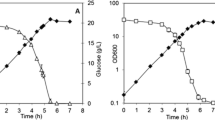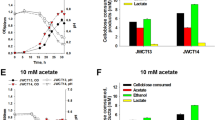Abstract
Survival after desiccation was highest for recombinant strains of E. coli engineered to produce ethanol (KO11 and LY163) and lactate (TG106) when sucrose was provided as the fermentable sugar. Desiccation tolerance was lower with glucose and xylose. Further improvements in desiccation tolerance with sucrose were obtained by combining this with increased expression of otsBA genes encoding trehalose biosynthesis, removal of products from metabolism by resuspending in fresh medium, and harvesting cells prior to the end of log phase. With sucrose and otsBA expression, survivals of 20%–80% were readily achieved. Fermentation tests with EM2L, a derivative of LY163 expressing ostBA, demonstrated that ethanol production from seed fermentations begun with desiccated cells is equivalent to that of an undesiccated control.




Similar content being viewed by others
References
Billi D, Wright DJ, Helm RF, Todd Prickett, Malcolm Potts, Crowe JH (2000) Engineering desiccation tolerance in Escherichia coli. Appl Environ Microbiol 66:1680–1684
Cayley S, Record MT (2003) Roles of cytoplasmic osmolytes, water, and crowding in the response of Escherichia coli to osmotic stress: biophysical basis of osmoprotection by glycine betaine. Biochem 42:12596–12609
Crowe JH, Hoekstra FA, Crowe LM (1992) Anhydrobiosis. Ann Rev Physiol 54:579–599
Csonka LN (1989) Physiological and genetic responses of bacteria to osmotic stress. Microbiol Rev 53:121–147
Garcia DE, Castro A, Bredholt H, Strom AR, Tunnacliffe A (2000) Anhydrobiotic engineering of gram-negative bacteria. Appl Environ Microbiol 66:4142–4144
Horlacher R, Uhland K, Klein W, Ehrmann M, Boos W (1996) Characterization of a cytoplasmic trehalase of Escherichia coli. J Bacteriol 178:6250–6257
Grabar TB, Zhou S, Shanmugam KT, Yomano LP, Ingram LO (2006) Methylglyoxal bypass identified as source of chiral contamination in L(+) and D(-)-lactate fermentations by recombinant Escherichia coli. Biotechnol Lett 28:1527–1535
Leslie SB, Israeli E, Lighthart B, Crowe JH, Crowe LM (1995) Trehalose and sucrose both protect membranes and proteins in intact bacteria during drying. Appl Environ Microbiol 61:3592–3597
Martinez A, Rodriguez ME, Wells ML, York SW, Preston JF, Ingram LO (2001) Detoxification of dilute acid hydrolysates of lignocellulose with lime. Biotechnol Prog 17:287–293
Morgan CA, Herman N, White PA, Vesey G (2006) Preservation of microorganisms by drying: a review. J Microbiol Methods 66:183–193
Ohta K, Beall DS, Shanmugam KT, Ingram LO (1991) Genetic improvement of Escherichia coli for ethanol production: chromosomal integration of Zymomonas mobilis genes encoding pyruvate decarboxylase and alcohol dehydrogenase II. Appl Eviron Microbiol 57:893–900
Poolman B, Glaasker E (1998) Regulation of compatible solute accumulation in bacteria. Mol Microbiol 29:397–407
Potts M (1994) Desiccation tolerance of prokaryotes. Microbiol Rev 58:755–805
Purvis JE, Yomano LP, Ingram LO (2005) Enhanced trehalose production improves growth of Escherichia coli under osmotic stress. Appl Environ Microbiol 71:3761–3769
Sampedro JG, Uribe S (2004) Trehalose-enzyme interactions result in structure stabilization and activity inhibition. The role of viscosity. Mol Cel Biochem 256/257:319–327
Strom AR (1998) Osmoregulation in the model organism Escherichia coli: genes governing the synthesis of glycine betaine and trehalose and their use in metabolic engineering of stress tolerance. J Biosci 23:437–445
Sussich F, Skopec C, Brady J, Cesaro A (2001) Reversible dehydration of trehalose and anhydrobiosis: from solution to an exotic crystal? Carbohydr Res 334:165–176
Welsh DT, Herbert RA (1999) Osmotically induced intracellular trehalose, but not glycine betaine accumulation promotes desiccation tolerance in Escherichia coli. FEMS Microbiol Lett 174:57–63
Yomano LP, York SW, Zhou S, Shanmugam KT, Ingram LO (2007) Reengineering Escherichia coli B for ethanol production from xylose in mineral salts medium. Metab Eng (Submitted for publication)
Acknowledgements
This research was supported by grants from the U.S. Department of Energy (FG02-96ER20222 and FG36-04GO14019), BioEnergy International, LLC, and Verenium Corp.
Author information
Authors and Affiliations
Corresponding author
Rights and permissions
About this article
Cite this article
Miller, E.N., Ingram, L.O. Sucrose and overexpression of trehalose biosynthetic genes (otsBA) increase desiccation tolerance of recombinant Escherichia coli . Biotechnol Lett 30, 503–508 (2008). https://doi.org/10.1007/s10529-007-9573-5
Received:
Accepted:
Published:
Issue Date:
DOI: https://doi.org/10.1007/s10529-007-9573-5




